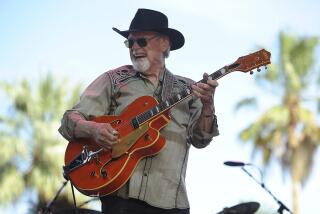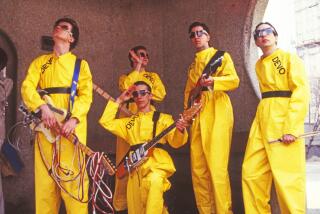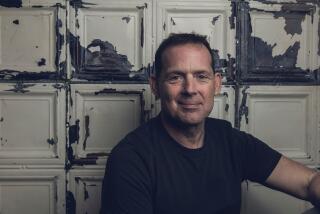ART OF NOISE GOT WRONG IMAGE BY AVOIDING ONE
- Share via
What happens when a group tries to keep from having an image?
In the case of the Art of Noise, it ended up with one anyway--and not necessarily one that it likes.
The English outfit, which is getting a lot of air play with its remake of the “Peter Gunn” theme, came together in 1983 under the wing of Zang Tuum Tumb, a company headed by producer Trevor Horn and pop propagandist Paul Morley.
In contrast to the big hype ZTT created for Frankie Goes to Hollywood, the Art of Noise was purposely left without a persona. In its absence, the group gained the image of being a studio creation of Horn’s and a humorless slave to the technology that is central to its influential big-beat sound-effects collages.
What do the members of the band think about that?
“In the early days we decided to be anonymous, and lo and behold somebody else got all the credit, namely Horn and Morley,” said Jonathan (J. J.) Jeczalik, one of the three anything- but -humorless people who make up the Art of Noise.
Jeczalik, who specializes in programming and playing the Fairlight computer sound-sampling keyboard, was in town recently with keyboardist and arranger Anne Dudley to promote the group’s new album “In Visible Silence” (the third member, Gary Langan, did not make the trip).
Out from under Horn’s Zang Tuum thumb as of the beginning of this year, the Art of Noise has launched a campaign to lift its veil of mystery--sort of.
Besides agreeing to do interviews, it is gaining attention with a “Peter Gunn” single--featuring the twangy guitar of Duane Eddy, who had a hit with the song in 1961--and its first-ever tour. Local shows are scheduled for the Palace on July 29 and the Pacific Amphitheatre on July 31.
It’s not as if the Art of Noise has turned into David Lee Roth, though. The group members are still reluctant to be photographed (faces are hidden in the group’s official publicity photo), and in the live shows the three keep themselves fairly inconspicuous among a host of guest performers. But they would like some of the credit that they believe is their due.
“None of us seeks to deny,” began Dudley, with Jeczalik finishing the thought (they often finish each others’ sentences), “the importance of Trevor and, to a lesser extent, Paul in our development. We carry no grudges.”
Added Dudley, “Without them we wouldn’t be sitting here now.”
The group’s experimental hybrid of musique concrete and contemporary dance styles--heard on its own 1983 hip-hop hit “Beat Box” as well as on recordings by Frankie Goes to Hollywood, ABC, Malcolm McLaren and many others--has had tremendous impact on pop music, movie scores and, perhaps most pervasively, television commercials.
“Even my mother, 70 years old and living in a small village in Oxfordshire, has noticed the number of (television) adverts using our kind of sounds,” Jeczalik said.
More important, though, the group wants to dispel the notion that it is a slave to its technology.
“The Art of Noise would rather play croquet than sit and program something,” insisted Jeczalik.
And in response to those who reflexively view computer-oriented music as calculated and mechanical, Dudley maintained, “An enormous amount of our music is improvised. . . .”
”. . . And played live to two-track,” finished Jeczalik.
It was this loose approach that led to the version of “Peter Gunn.”
“We liked the idea of basing something around a bass riff, and we kept coming back to this,” said Dudley of the piece’s familiar spy-theme melodic figure.
“We couldn’t get around the fact that we hadn’t written it,” recalled Jeczalik with a laugh.
“So we thought, ‘Let’s go whole hog and get the real chap in,’ ” continued Dudley, referring to guitarist Eddy. Much to the group’s surprise, Eddy was quite receptive to the idea.
Even the presence of Eddy’s warm twang, though, has not been enough to humanize the Art of Noise in the eyes of some. Said Jeczalik, “The funny thing in England is reviewers supposed we sampled Duane’s sound and used the technology to play with it.”
While he admits that technology makes that sort of thing possible, Jeczalik insists that the Art of Noise would much prefer to work with live bodies than exclusively with machines.
And he gave one good reason why: “There aren’t any synthesizers that can tell a joke.”
More to Read
The biggest entertainment stories
Get our big stories about Hollywood, film, television, music, arts, culture and more right in your inbox as soon as they publish.
You may occasionally receive promotional content from the Los Angeles Times.










